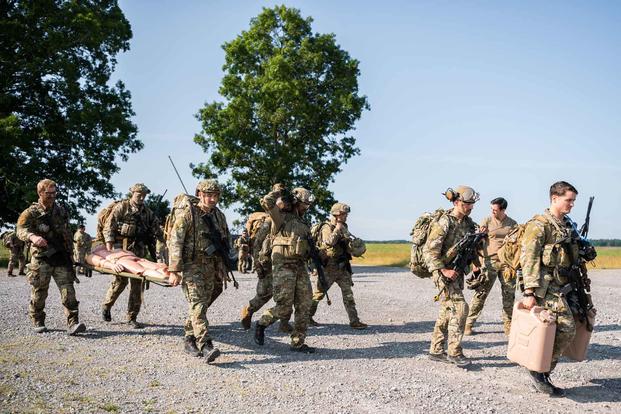As Congress moves toward retiring more A-10 Warthogs from service, the Air Force also aims to cut over the next three years the number of elite airmen responsible for calling in close-air support on the battlefield.
Rose Riley, a Department of the Air Force spokeswoman, confirmed to Military.com that the service plans to shrink the Tactical Air Control Party, or TACP, job field to about 2,130 positions -- a decrease of 44%, according to the service. The Air Force said the manning is now "roughly" 3,700 airmen.
"Currently, there are no plans to retrain TACPs to other career fields in light of the manning reduction, but the Air Force is opening opportunities for those who would prefer to pursue other careers," Riley said.
Read Next: Lawmakers Advance Bill to Let Disabled Vets Collect Full Benefits, But Hurdles to Passage Remain
Tactical Air Control Party airmen are part of a special warfare job in the Air Force and embed with other services to help scout and guide air support in the heat of battle. It's one of the service's toughest jobs and involves rigorous physical training and hazardous assignments.
But these cuts come as the Air Force seeks to reassess its close-air support capabilities amid escalating tensions with China, even looking to scrap more A-10 Warthogs -- one of the main airframes that TACPs have worked with -- in the 2024 National Defense Authorization Act.
In the next three fiscal years, the Air Force is asking to decrease TACPs by "44% to approximately 2,130 positions with a reduction of roughly 370 positions in FY23, 610 positions in FY24, and 600 positions in FY25," Riley said in an emailed statement.
The Tactical Air Control Party field has remained, historically, around 80% manned, Riley said. The service would try to make cuts from that unmanned 20% first.
The decrease from 3,700 down to 2,130 airmen is just over a 42% cut, and it was not immediately apparent how the Air Force was calculating the slightly higher reduction.
While Riley added that TACPs remain an important part of the Air Force's strategy and that they will "become even more imperative as the Department of Defense postures toward strategic competition after focusing on counterinsurgency for the last 20 years," some veterans remain skeptical.
News of the TACP reduction was first reported by Military Times in April. Troops-In-Contact, an advocacy group led by A-10 and air support veterans, issued a statement after the cuts were revealed saying close-air support, or CAS, is crucial to the military. The group argued that the results of cutting TACPs could be deadly.
"If successful, this plan would kill the CAS profession and cripple America's CAS capability," the group wrote on its website. "Ground troops would be supported, if at all, by CAS amateurs in a small, expensive fleet of fragile aircraft that are far less effective. In Low Intensity Conflict, that will cost lives."
The group has also fought against cuts to the A-10 Warthog, the close-support aircraft with a more than 57-foot wingspan has been flown by the military since the 1970s. Known for its menacing 30-mm Gatling-style guns, the aircraft protected troops in Iraq and Afghanistan, as well as the first Gulf War.
But Air Force officials haven't run to the A-10's rescue.
Air Force Chief of Staff Gen. Charles "C.Q." Brown, who has been nominated as the next chairman of the Joint Chiefs of Staff, told reporters at the Air and Space Forces Association's Air Warfare Symposium in March that he expected the service to retire all A-10s by 2028 or 2029. He argued that the F-35A Lightning II is capable of providing close-air support.
"I would say over the next five or six years we will probably [have] the A-10 out of our inventory," Brown told reporters. "The A-10 is a great airplane. It's a great airplane in an uncontested environment. The challenge is we're going to be in more contested environments in the future."
-- Thomas Novelly can be reached at thomas.novelly@military.com. Follow him on Twitter @TomNovelly.
Related: A-10s Were Saved from Retirement for Years. Congress May Not Swoop to the Rescue This Time.












